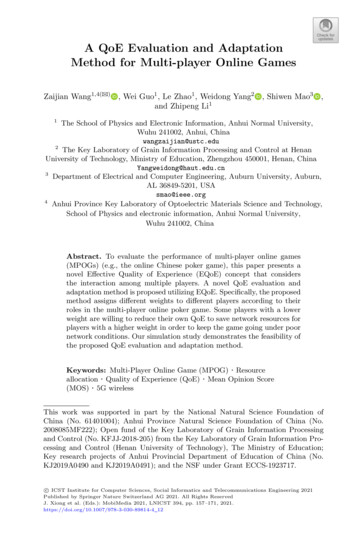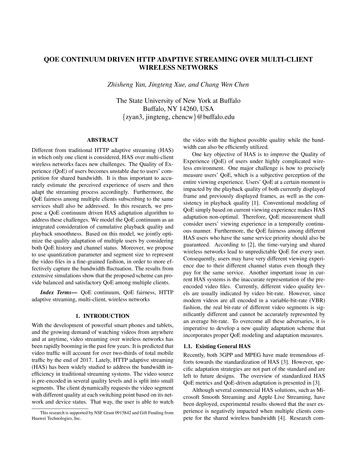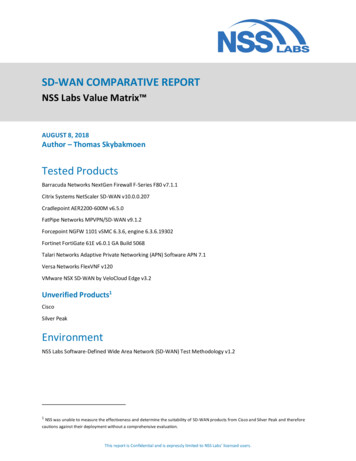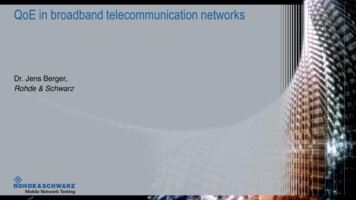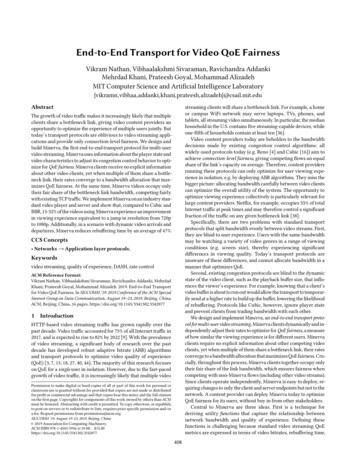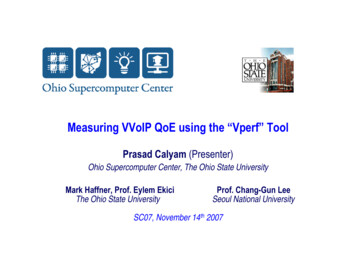
Transcription
Application-based QoE support with P4 andOpenFlowDivyashri Bhat † , Jason Anderson† , Paul Ruth‡ , Michael Zink and Kate Keahey§University of Massachusetts Amherst , University of Chicago† , RENCI‡ , Argonne National Labs § dbhat,zink@ecs.umass.edu, † jasonanderson@uchicago.edu, ‡ pruth@renci.org, § keahey@mcs.anl.gov,Abstract—Although Software-Defined Wide Area Networks(SD-WANs) are now widely deployed in several productionnetworks, they are largely restricted to traffic engineering approaches based on layer 4 (L4) of the network protocol stackthat result in improved Quality-of-Service (QoS) of the networkoverall without necessarily focussing on a specific application.However, the emergence of application protocols such as QUICand HTTP/2 needs an investigation of layer 5-based (L5) approaches in order to improve users’ Quality-of-Experience (QoE).In this paper, we leverage the capabilities of flexible, P4-basedswitches that incorporate protocol-independent packet processingin order to intelligently route traffic based on application headers.We use Adaptive Bit Rate (ABR) video streaming as an exampleto show how such an approach can not only provide flexibletraffic management but also improve application QoE. Ourevaluation consists of an actual deployment in a research testbed,Chameleon, where we leverage the benefits of fast paths in orderto retransmit video segments in higher qualities. Further, weanalyze real-world ABR streaming sessions from a large-scaleCDN and show that our approach can successfully maximizeQoE for all users in the dataset.I. I NTRODUCTIONWhile application protocols such as HTTP have evolved toprovide reduced latency and efficient use of network resources[1], traffic engineering paradigms such as Software DefinedNetworking (SDN) have simultaneously emerged to providebetter Quality-of-Service (QoS) through flexible routing andcentralized network management. Several large-scale production Content Distribution Networks (CDNs) such as Google[2] have implemented Software-Defined Wide Area Networks(SD-WANs) to efficiently perform application-aware routingat the peering edge. Cisco [3], predicts that downstreamapplication traffic will account for 82% of all Internet trafficby 2021. Moreover, the same report predicts that SD-WANtraffic will account for 25% of all WAN traffic by 2021.On the application layer, HTTP/2 incorporates several improvements over its predecessor, HTTP/1, which include a)multiplexing several streams into one TCP connection, b)server-push approaches, where content is delivered to a clientwithout explicitly requesting it, and c) header compressionfor reduced latency. These improvements, particularly streammultiplexing, were devised to reduce page load time suchthat download requests for embedded objects such as images,video, etc., in a web page can be issued simultaneously(instead of sequentially). Similarly, the QUIC [4] protocol wasintroduced as a transport layer candidate for HTTP/2 with onebasic difference: QUIC is based on UDP and can thus, be usedQuality levelNumber indicates priorityof segments 234567Original gap(1 segment length).Need to retransmitsegment 3 (8) at qualitylevel 6 to closegap.89101112131415retransmissionbuffer in # ofsegmentsOriginal gap(2 segment lengths).Need to retransmit segments 13 & 14at quality level 4 to close gapFig. 1: Example scenario for retransmissions. The QoE of thisstreaming session can be improved if, e.g., segments 3, 8, 13,and 14 are retransmitted in higher quality, assuming they arrivebefore their scheduled playout.to implement flexible congestion control as well. As protocolsbecome more versatile to support high-bandwidth applicationssuch as Adaptive Bit-Rate (ABR) video streaming, AugmentedReality (AR) and Virtual Reality (VR) applications, networkarchitectures need to adapt in order to meet the demands ofsuch applications worldwide. More recently, the introductionof flexible switch architectures such as [5] have paved the wayfor line-rate processing of application-layer headers [6]. Ourarchitecture investigates application-based QoS in centrallycontrolled networks. In particular, this work leverages thecapability of protocol-independent packet processors (P4) [5]at the edge of the network to define a custom fixed-lengthapplication header and further, translate this into a Q-in-Q(802.1ad) tag [7] for the core network in order to performQoS routing/provisioning.The remainder of this paper provides a background ofapplications such as video streaming that can benefit from ourapproach in Sect. II. A detailed description of our architectureis given in Sect. III, followed by our Chameleon testbed setupdescription in Sect. IV. We then present an evaluation of ourprototype in Sect. V followed by the Conclusion in Sect. VI.II. BACKGROUNDWhile we envision that several applications today canbenefit from application header-based traffic engineering usingP4, in this work we target popular applications such as videostreaming in order to demonstrate the gains of our approach.
III. D ESIGNFig. 2: Tile-based Virtual Reality (VR) video streaming. Aviewport is characterized by multiple adjacent tiles that need tobe simultaneously downloaded in order to provide a seamlessviewing experience to the user.In this section, we introduce the design of our approachby first describing application header-based traffic engineeringfollowed by an explanation of the system architecture. Although from a designer’s perspective it may seem attractive toperform application header-based traffic engineering throughout the network, we believe that from a network managementand scalability vantage point, such type of traffic engineeringis most suitable for the network edge. In the following, we describe the design of our system where application header-basedtraffic engineering at the edge can be seamlessly integratedwith existing traffic forwarding contexts in core networks.A. Application header-based Traffic EngineeringEthernet II Frame(untagged)First, we focus on ABR video streaming as an example anduse Figure 1 to show a simplified example of segment qualitiesinside the video player buffer with different possible qualitygaps. In previous work [8], we demonstrated how HTTP/2based multiplexing can be used to simultaneously fetch multiple qualities of video segments (denoted retransmissions) inorder to close such gaps and thereby, improve the Qualityof-Experience (QoE) of a client. In this work, we analyzehow traffic engineering approaches can also be used to provideimproved QoE by retransmitting segments using a faster path,when available.The second example we consider focuses on more recentlyevolved 360 streaming applications for VR/AR that are quicklygaining traction as popular video streaming applications. Suchhigh-bandwidth, latency sensitive applications continue topush the boundaries of current network architectures and driveinnovation in traffic engineering approaches. Fig. 2 showsan example of tile-based 360 streaming where each sceneis split into tiles that are rendered as the user moves theirhead. As is evident from this figure, such an application wouldrequire multiple tiles to be downloaded concurrently in orderto render a ”Viewport” for the user. Furthermore, each of thesetiles may need to be retransmitted in higher qualities if theyexperience quality gaps as shown in Fig. 1. In order to providean evaluation of simultaneous tile downloads, in this work wewill also analyze the benefits of transmitting multiple streamsover a fast path, when available.In previous work [9], we demonstrated a prototype whereHTTP/2 header information can be translated as a QoSrequirement using P4-capable network elements to convertapplication layer header information into a Q-in-Q tag fordifferentiated routing via the core network using the BringYour-Own-Controller (BYOC) feature [10] provided by theChameleon testbed [11]. In this work, we conduct extensiveevaluations in order to analyze the QoE improvement for ABRstreaming applications. We also use traces from an actuallarge-scale CDN to conduct an analysis of real-world ABRsessions to show that P4-based ABR segment retransmissionscan be used to maximize the QoE for all sessions in the trace.Destination SourceEtherTypeMACMACPayload(2 bytes)(6 bytes) (6 bytes)VLANtagged(802.1Q)Destination SourceMACMAC(6 bytes) (6 bytes)TPID0x8100802.1Q Header(4 bytes)VLANCFIPriorityTPID0x8100802.1Q Header(4 bytes)VLANCFIPriorityQ-in-Q VLANtagged(802.1ad)Destination SourceMACMAC(6 bytes) (6 bytes)C-TAGVLANIDVLAN IDEtherTypePayload(2 bytes)TPID0x8100802.1Q Header(4 bytes)VLANCFIPriorityVLAN IDEtherTypePayload(2 bytes)S-TAGFig. 3: VLAN tag header insertion in Layer-2. 802.1Q is followed by 802.1ad in order to differentiate between customerson the same VLAN.1) Q-in-Q: The IEEE 802.1ad standard [7] double-taggingis introduced to allow network service providers to separatetraffic from different VLANs as well as customers for bettertraffic management. Here, we use Q-in-Q tunneling, illustratedin Fig. 3, to translate application-layer header information intolink-layer headers at the edge before packets are forwardedto the core network. In particular, we focus on HTTP/2application headers since they explicitly provide header fieldsthat can be easily interpreted into Q-in-Q tags for bettermanageability.Fig. 4: HTTP/2 Header Format: Common Eight-Byte Header2) HTTP/2 Header: As the number of objects embeddedwithin a web page began to increase, the overhead due tovariable length headers resulted in increased page load timesfor HTTP/1.1. Contrarily, HTTP/2 introduces a fixed lengthheader and performs header compression in order to reduceperceived latency and increase goodput [12]. It is interestingto note that HTTP/2 explicitly defines the Stream ID field(see Fig. 4) to multiplex several streams into a single TCPconnection and thus, can be re-interpreted as a Q-in-Q tag
onitoringRequest NetworkInformationControlInstallFlowSwitchSend NetworkInformationMonitoringStatsRequestConnection RequestStatsReplyNORTHBOUNDControl PlaneSOUTHBOUNDData PlaneEDGEHomeEDGEEDGECORE3) Orchestration and Visualization: Our system also includes a centralized component that aggregates monitoringinformation from the various controllers in order to providea visual representation of network performance.The diagram also shows clients that connect to the edgevia wireless home networks and cellular networks and receiverequested content from a server connected to a different edge.The two edge networks are connected by the core. In thefollowing section, we describe the setup for our experimentsincluding the platform and tools we use to run QoE translationexperiments.CellularIV. S ETUPFig. 5: Architecture for QoE to QoS translation at the edge,which is envisioned as SD-WANsby any link-layer device. In this work, we redefine the outercustomer tag (C-TAG) as a Stream ID tag using a flexible,protocol-independent packet processing language, P4 that canbe programmed to interpret HTTP/2 headers. For the ABRvideo streaming application, Stream ID is used to differentiatebetween two distinct bitrate qualities that are simultaneouslydownloaded by the client as described in our previous work[8].B. System ArchitectureThe main focus of our architecture is to translateapplication-layer header information into link-layer headers.We additionally include a centralized component that allowsnetwork providers to orchestrate and visualize their networkfrom a single interface. Figure 5 presents the architecture ofour system and consists of the following components:1) The Core: For our architecture we assume a capabilitysimilar to that of a large-scale research testbed, ESNET1 ,where the core or backbone network includes a programmabledata-plane that performs fine-grained traffic engineering basedon L2-L5 header information and is centrally controlled byan independent controller (denoted as Monitoring and Controlin Fig. 5). However, we note that similar functionality canbe incrementally deployed in production networks based onMPLS Traffic Engineering (MPLS-TE)2 techniques as well.2) The Edge: Innovation at the edge such as SD-WANs[2] is driven by the tremendous growth in downstream application traffic and the advent of cloud computing. Here,the edge network also includes a programmable data-planeof several flexible switches that are centrally controlled by anindependent controller. However, these switches can performfine-grained traffic engineering using L5 header information aswell. In order to peer with the core, the edge controller musttranslate information in L5 headers to L2-L4 headers beforesending packets out into the core.1 twork-testbeds/100g-sdn-testbed/2 raffic-engineering/A. Chameleon TestbedThe Chameleon testbed is a deeply reconfigurable testbedthat is suitable for large-scale prototyping of distributed systems and software defined networks. In this work, we leveragethe recently released Bring-Your-Own-Controller feature [10]along with previously existing capabilities of the ChameleonCloud to create a prototype of our architecture. Figure 6 showsthe setup of our testbed, which is described next in more detail.1) HTTP/2 application: For the HTTP/2 application weinstantiate two bare-metal nodes: one that runs a Web serverusing the open source Caddy (version 0.10.10) software andanother that runs an ABR video streaming client, AStream3 ,that we modify to use an open-source Python-based library,hyper4 , that downloads video content using HTTP/2.2) P4 Switch[5]: We install the behavioral model, BMV25 ,software switch in a bare-metal node, which emulates aP4-capable switch, and then use the P4Runtime6 tool toprogrammatically install rules into each switch. In the future,we plan to replace this component with a hardware ASIC P4switch [13] that has only recently become available.3) OpenFlow Switch: OpenFlow [14], a widely-used implementation of SDN, is available to experimenters as a VirtualForwarding Context (VFC), a functionality provided by Corsaswitches, which enables each user to provision a nearlyisolated instance of an OpenFlow (v1.3) switch. A single CorsaDP2000 switch deployed within the Chameleon testbed at eachsite provides experimenters with performance measurementsfor a virtual instance of a hardware switch comparable tothose used in production networks today. Each VFC can beprogrammed to connect to an individual SDN controller suchthat each user’s experiment is truly isolated from others. AfterHTTP/2 headers are translated into Q-in-Q tags as describedin Sect. III-A2, application packets are forwarded through theCorsa switch into the core network.4) Core Network: In this setup, we provision two VLANcircuits (denoted as Circuit1 and Circuit2) between the University of Chicago (UC) and the Texas Advanced ComputingCenter (TACC) using the Advanced Layer-2 Service (AL2S)3 https://github.com/pari685/AStream4 https://github.com/Lukasa/hyper5 https://github.com/p4lang/behavioral-model6 https://github.com/p4lang/PI
CHAMELEONTESTBED SETUPSDN Controller(RYU)CENTRALIZED NETWORKMANAGEMENT ANDCONTROLCROSSTRAFFICCROSSTRAFFICP4 RFAST . 6: Chameleon Testbed Setup: A HTTP/2 based video streaming client uses two disjoint paths to request multiple qualitiesof the same segment. Note: The disjoint points provide us with a setup to run controlled measurements with differential QoSfeatures and study their effects on ABR retransmissions.implemented by Internet2, which is a network service providerfor collaborative research7 . Note that the cross traffic nodesare bare-metal machines used to limit network bandwidth to1Gbps using Iperf38 on Circuit1.5) Centralized Management and Control: For orchestrationand visualization, we use Jupyter Notebooks [15], an opensource web tool particularly suited for reproducible experiments. For this evaluation, Jupyter runs inside Chameleonand provides us with a single interface not only to run thecontroller and the ABR video streaming application but alsoto visualize network traffic and QoE metrics.V. E VALUATIONA. Download Time and ThroughputFigure 7 illustrates the performance improvement for ABRsegment download time and throughput with the use ofP4-based traffic engineering. In order to provide statisticalsignificance to our evaluations, each experiment is repeatedten times and average and standard deviations are presented.Circuit1 and Circuit2 are 10Gbps isolated paths provisionedby AL2S between Chicago and Austin with an inherent delayof 30ms and a loss of 0%. Here, we consider a Baseline case,where all ABR segment are transmitted on the same pathversus the case where retransmitted segments are sent overa prioritized path (denoted FAST PATH in Fig. 6). In order toobserve the benefits of using a FAST PATH for applicationdata transfer, all experiments described in this section areconducted by increasing loss and delay on Circuit1, unlessstated otherwise. In order to make our analysis more generallyapplicable, we first describe performance improvements forsegment download time and application throughput, which aresubsequently translated to QoE metrics for ABR streamingtowards the end of this section.1) Single HTTP/2 Streams: Fig. 7a presents experimentswhere a single stream is provisioned on each path, i.e., original segments are downloaded on Circuit1 and retransmittedsegments are downloaded on Circuit2. The download time andapplication throughput for simultaneous segment downloadsis compared against a Baseline case where both original andretransmitted segments are downloaded on Circuit1. Here, we7 ed-networking/layer-2-services/#features-al2s8 https://iperf.fr/iperf-download.phpevaluate five different network conditions of increasing delay(denoted D) and loss (denoted L) on Circuit1 in order to studythe benefit of using the FAST PATH for a single retransmissionstream. While it is obvious that no improvement is observedin the case where D 0 with no added delay on both circuits,significant improvements for download time and throughputare observed under different network conditions. We notethat relatively higher performance improvements are observedwhen compared with high delay networks and we attributethis to the following: The application we show here uses TCPwhich is impacted by its slow start behavior and therefore, highround-trip times drastically impact the average throughput,especially for downloads of a short duration.2) Multiple HTTP/2 Streams: While the above experimentshows L5 header-based traffic engineering is feasible andbeneficial for ABR streaming sessions where a maximumof two streams are downloaded simultaneously, emergingapplications such as 360 VR/AR streaming generally consistof multiple concurrent streams per session as illustrated in Fig.2. Thus, Fig. 7b extends the evaluation of our system to include performance improvements when multiple segments aredownloaded simultaneously. Since considerable improvementis observed in the case where Circuit1 is characterized by adelay of 50ms and average loss of 0.5%, we focus on thisscenario for evaluating cases where the number of streamsis systematically increased. We note that while benefits arehighest when a single stream is transmitted on each path,throughput is improved by about 30% and segment downloadtime by more than 20% in cases when the number of streamsper path are increased to two, four and eight, respectively.In order to further understand the scalability of the system,the next set of experiments focusses solely on the processingoverhead observed at the P4 software switch when the numberof streams is systematically increased.3) Processing Overhead - BMV2: Fig. 8 shows the percentage of processing overhead for the software switch incomparison to the case where a single stream is downloaded oneach path. As the number of streams exponentially increasesper path, we observe that the duration of segment download iscorrespondingly higher. We note that since these experimentsare conducted with zero added delay and loss on each pathand the software switch runs within a standalone bare-metalmachine, any differences observed can be attributed to the
100100Download TimeThroughput80Performance Improvement [%]Performance Improvement [%]806040200D 0msDownload TimeThroughputL 0.5%L 1%D 50msD 50msL 0.5%D 50msL 1%(a) Original and retransmitted segment streams aredownloaded on separate paths.6040200D 50ms,L 0.5%Streams 1D 50ms,L 0.5%Streams 2D 50ms,L 0.5%Streams 4D 50ms,L 0.5%Streams 8(b) Several streams are downloadedsimultaneously where the number of streams issymmetrically distributed between two paths.Fig. 7: Performance improvements for file transfer time and application throughput under varying network conditions.Comparisons with a baseline case where all streams are downloaded on a single path, i.e., Circuit1 show significant benefitswhen a second, faster path is used for downloading retransmitted segments.CPU processing time on the software switch.800Download TimeProcessing Time Overhead [%]700C. Trace-based simulation6005004003002001000in the number of quality gaps due to retransmissions results ina corresponding reduction in the number of quality switchesfor an ABR streaming session.Streams 2Streams 4Streams 8Fig. 8: Processing time overhead for the P4 software switchwith simultaneous HTTP/2 streams shows that performance isCPU-bound.B. QoE metrics for ABR StreamingFor the evaluation of the performance impact of the trafficengineering approach we present in this paper on ABR streaming, we make use of the following metrics, which are widelyused in related work:Average Quality Bitrate (AQB): One of the objectivesof quality adaptation algorithms is to maximize the averagequality bitrate of streamed video. Note that an increased application throughput contributes to an improvement in the averagequality bitrate for ABR video streaming. For a comprehensiveQoE representation, we need to combine this metric with theNumber of Quality Switches which is explained below.Number of Quality Switches (#QS): This metric is usedtogether with AQB to draw quantitative conclusions aboutthe perceived quality (QoE). For example, for two streamingsessions having the same AQB, the session with the lower#QS will be perceived better by the viewer [16]. A reductionIn this section, we analyze actual sessions from a popular CDN (Akamai) [17] in order to obtain an estimate ofQoE improvements when differentiated traffic engineeringis performed for original and retransmitted segments. Thisdataset contains video streaming session information for a 3day period in June 2014. The ABR streaming traffic in thistrace contains 5 million video sessions originating from over200,000 unique clients who were served by 1294 edge serversaround the world. For each streaming session, each individualsegment request is logged, which allows us to reconstruct thequality of the segments received at the client.Fig. 9a shows the average number of retransmissions persession that need to be made in order to close quality gaps asillustrated in Fig. 1. We note that about 36.19% of sessionsrequire at least one retransmission while some sessions mayeven require up to 300 retransmissions [8].Fig. 9b illustrates the percentage improvement in averagequality bitrate required in order to maximize QoE for eachsession. For example, 20% of the video streaming sessions inthis dataset only need a 10% improvement in average qualitybitrate in order to maximize their QoE. When we combine thiswith the results obtained in Fig. 7a, assuming that a similarquality profile is observed in our testbed network, we note thatnearly all sessions can maximize their QoE by using a highpriority path for retransmitting segments in a higher quality.These benefits are especially significant when the default pathsuffers from large round-trip times as high as 50ms. Further,the number of quality changes, #QS, are minimized byperforming retransmissions using the FAST PATH whenevernecessary, since this is a natural by-product of closing gaps.
1.01.0All Sessions0.80.80.6CDFCDF0.60.40.40.20.2All Sessions0.0050100150200250Number of segment retransmissions300(a)0.00102030inAverage Quality Bitrate [%]4050Improvement(b)Fig. 9: Analysis from a real-world trace show projected QoE improvements with the use of ABR segment retransmissions.Although we present relative improvements to QoE with theuse of P4 software switches to perform application headerbased traffic engineering, it is important to note that theirperformance is CPU-bound and not I/O bound. It is, therefore, recommended to consider software switches only forprototyping systems and implement hardware switches suchas Barefoot’s Tofino [13] in production networks.VI. C ONCLUSIONIn this work, we show how flexible switches at the edge canbe used to translate application layer header information intolink layer headers to differentially route distinct qualities ofABR video segments in order to improve the average qualitybitrate of a HTTP/2-based video streaming application. Weperformed evaluations in a geographically distributed testbed,Chameleon, using open source orchestration and visualizationtools. Our results show that application header-based trafficengineering techniques can vastly improve users’ QoE. Inorder to conduct large-scale performance evaluations of QoEimprovements for P4-based traffic engineering approaches, ourfuture work will focus on using hardware switches that processL5 headers at line-rate speeds.VII. ACKNOWLEDGMENTSResults presented in this paper were obtained using theChameleon testbed supported by the National Science Foundation. This material is based upon work supported by the U.S.Department of Energy, Office of Science, under contract number DE-AC02-06CH11357 and the DyNamo grant awardedby the National Science Foundation, Office of AdvancedCyberinfrastructure under contract number #1826997.R EFERENCES[1] R. P. Mike Belshe and M. Thomson, “Hypertext Transfer ProtocolVersion 2 (HTTP/2),” Internet Requests for Comments, RFC Editor, RFC7540, May 2015. [Online]. Available: https://tools.ietf.org/rfc/rfc7540.txt[2] K.-K. Yap, M. Motiwala, J. Rahe, S. Padgett, M. Holliman, G. Baldus,M. Hines, T. Kim, A. Narayanan, A. Jain, V. Lin, C. Rice, B. Rogan,A. Singh, B. Tanaka, M. Verma, P. Sood, M. Tariq, M. Tierney,D. Trumic, V. Valancius, C. Ying, M. Kallahalla, B. Koley, andA. Vahdat, “Taking the edge off with espresso: Scale, reliability andprogrammability for global internet peering,” in Proceedings of theConference of the ACM Special Interest Group on Data Communication,ser. SIGCOMM ’17. New York, NY, USA: ACM, 2017, pp. 432–445.[Online]. Available: http://doi.acm.org/10.1145/3098822.3098854[3] rking-index-vni/vni-hyperconnectivity-wp.pdf[4] A. Langley, A. Riddoch, A. Wilk, A. Vicente, C. Krasic, D. Zhang,F. Yang, F. Kouranov, I. Swett, J. Iyengar, J. Bailey, J. Dorfman,J. Roskind, J. Kulik, P. Westin, R. Tenneti, R. Shade, R. Hamilton,V. Vasiliev, W.-T. Chang, and Z. Shi, “The quic transport protocol:Design and internet-scale deployment,” in Proceedings of the Conferenceof the ACM Special Interest Group on Data Communication, ser.SIGCOMM ’17. New York, NY, USA: ACM, 2017, pp. 183–196.[Online]. Available: http://doi.acm.org/10.1145/3098822.3098842[5] P. Bosshart, D. Daly, G. Gibb, M. Izzard, N. McKeown, J. Rexford,C. Schlesinger, D. Talayco, A. Vahdat, G. Varghese, and D. Walker,“P4: Programming protocol-independent packet processors,” SIGCOMMComput. Commun. Rev., vol. 44, no. 3, pp. 87–95, Jul. 2014. [Online].Available: http://doi.acm.org/10.1145/2656877.2656890[6] X. Jin, X. Li, H. Zhang, R. Soulé, J. Lee, N. Foster, C. Kim, and I. Stoica,“Netcache: Balancing key-value stores with fast in-network caching,” inProceedings of the 26th Symposium on Operating Systems Principles.ACM, 2017, pp. 121–136.[7] Provider Bridges, IEEE Std. 802.1ad, 2006.[8] D. Bhat, R. Deshmukh, and M. Zink, “Improving qoe of abr streamingsessions through quic retransmissions,” in Proceedings of the 26thACM International Conference on Multimedia, ser. MM ’18. NewYork, NY, USA: ACM, 2018, pp. 1616–1624. [Online]. 64[9] D. Bhat, J. Anderson, P. Ruth, M. Zink, and K. Keahey, “Applicationbased qos support with p4 and openflow: A demonstration usingchameleon,” Semantic Scholar, 2018.[10] P. Ruth, “Software-defined networking with chameleon,” 2018.[Online]. Available: chnical/networks/networks sdn.html[11] K. Keahey, P. Riteau, D. Stanzione, T. Cockerill, J. Mambretti, P. Rad,and P. Ruth, “Chameleon: a scalable production testbed for computerscience research,” in Contemporary High Performance Computing vol.3. Ed. Jeff Vetter., 2017.[12] I. Grigorik and Surma, “Introduction to http/2,” 2019.[Online]. Available: formance/http2/[13] Barefoot, “Tofino: World’s fastest p4-programmable ethernet switchasics,” 2019. [Online]. Available: fino/[14] N. McKeown, T. Anderson, H. Balakrishnan, G. Parulkar, L. Peterson,J. Rexford, S. Shenker, and J. Turner, “OpenFlow: Enabling Innovation in Campus Networks,” ACM SIGCOMM Comput. Commun. Rev.,vol. 38, no. 2, Mar. 2008.[15] T. Kluyver, B. Ragan-Kelley, F. Pérez, B. E. Granger, M. Bussonnier,J. Frederic, K. Kelley, J. B. Hamrick, J. Grout, S. Corlay et al.,“Jupyter notebooks-a publishing format for repro
Application-based QoE support with P4 and OpenFlow Divyashri Bhat y, Jason Anderson , Paul Ruthz, Michael Zink and Kate Keaheyx University of Massachusetts Amherst, University of Chicagoy, RENCIz, Argonne National Labs x dbhat,zink@ecs.umass.edu, yjasonanderson@uchicago.edu, zpruth@renci.org, xkeahey@mcs.anl.gov, Abstract—Although Software-Defined Wide Area Networks
